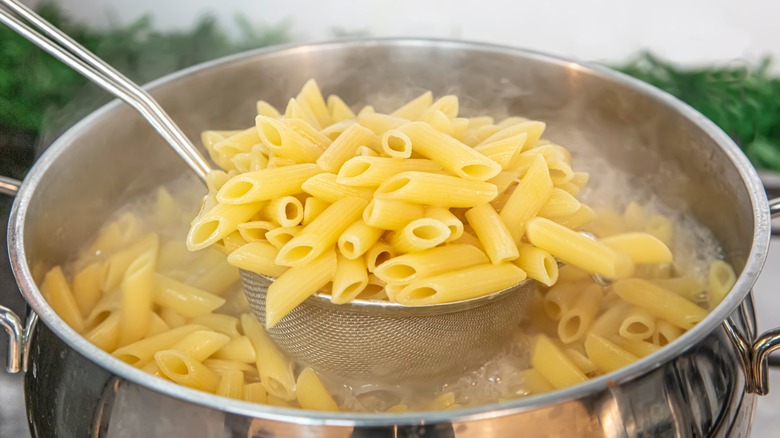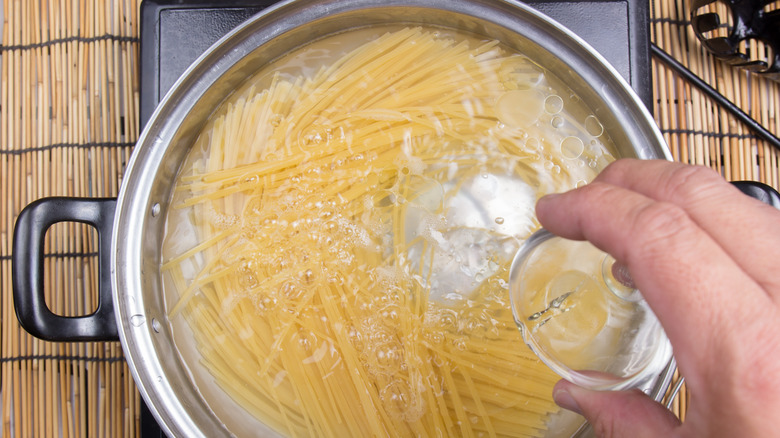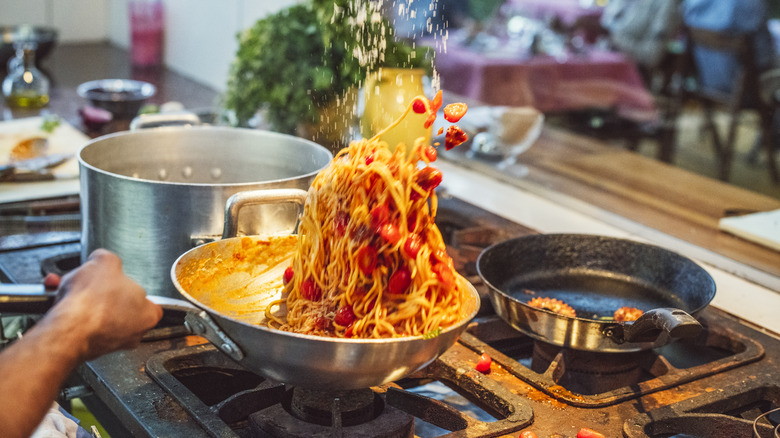The Biggest Pro And Con Of Adding Olive Oil To Pasta Water
Tips abound on making the perfect pot of pasta, and rightfully so. The global market for pasta reached a value of $43.63 billion in 2021, per Fortune Business Insights, making it one of the world's most favorite foods. Statistics aside, what really matters on a personal level is perfecting those coveted noodles in your own kitchen.
Regardless of which pasta shape you're cooking, from stringy spaghetti to tubular penne, twisted fusilli, or curly macaroni, what you put in (or leave out of) the water defines the outcome. Little things really add up to getting it "just right," from timing to pot size, and whether (and when) to add salt during the cooking process. There's also the conundrum of including olive oil in the pasta water while it boils, a practice that often elicits very passionate "for" and "against" opinions.
Is adding olive oil to pasta water really that big of a deal? Apparently so, based on endless insights from professional chefs, home kitchen enthusiasts, and even leading industry purveyors like Barilla. The pros and cons of sliding olive oil into boiling pasta basically come down to three main issues: pasta noodles clumping together in the pot; pasta water boiling over; and sauce sticking insufficiently to cooked noodles.
Pro: Noodles are less likely to stick together
Those giving a thumbs up to adding olive oil to boiling pasta water note that it does help lubricate the noodles and keeps them from hugging together while they heat up. This helps avoid lumpy pasta that can result in uneven cooking, often leaving you with an unappetizing gummy texture that's either under-cooked or over-cooked. Using a good, high-quality olive oil will also enrich the flavor, say advocates, and potentially add nutrients from the oil itself.
Another benefit of oil infusion in pasta water is that it helps keep boiling water from spilling over the top of the pot and making a mess. When boiling pasta, you may have noticed the pot can erupt like a foaming gusher with little warning. That's because of the starches and proteins released as the pasta heats up that linger around the water surface inside, eventually overflowing when bubbles collect the dissolved starches and push their way overboard. Olive oil in the water can circumvent this by sliding between the noodles and preventing starchy buildup.
It's worth mentioning that olive oil isn't the only solution for keeping noodles apart. A more tedious method when cooking dried pasta is constant stirring, which is tough when coordinating other meal components such as sauce and bread. You could also use a large pot with enough room for the noodles to bubble at a good distance from one another.
Con: Sauce might not stick to the noodles
On the other side of the olive oil in pasta water debate are the detractors who say doing so will prevent the eventual marriage of noodles and sauce on your plate. Oil coats the noodles while they roll around, keeping them separate while cooking, but it also creates an oily layer on top of the water. When eventually draining the water, the oil will coat the pasta yet again.
It seems logical that slippery, oily noodles would resist binding to tomato, pesto, alfredo, or other types of pasta sauces — but it's not quite that simple. For example, almost any sauce you buy or create already contains oil, and quite often it's olive oil. So there's a good chance that any oil that does remain on cooked pasta will merge with the existing oil in the sauce, naturally blending together. For cooks that plan ahead and make pasta and sauce to eat a day or two later, any olive oil retained during cooking can also keep cold noodles from clumping together in starchy globs. The same goes if the planned meal is a cold pasta salad.
So, while the effect of slippery noodles can land the olive oil prep step in the "con" column, it really comes down to how you eventually prepare your pasta dish: Some chunky meatballs, large stewed tomato bits, or fresh al dente vegetables can work wonders in keeping saucy pasta in place.



